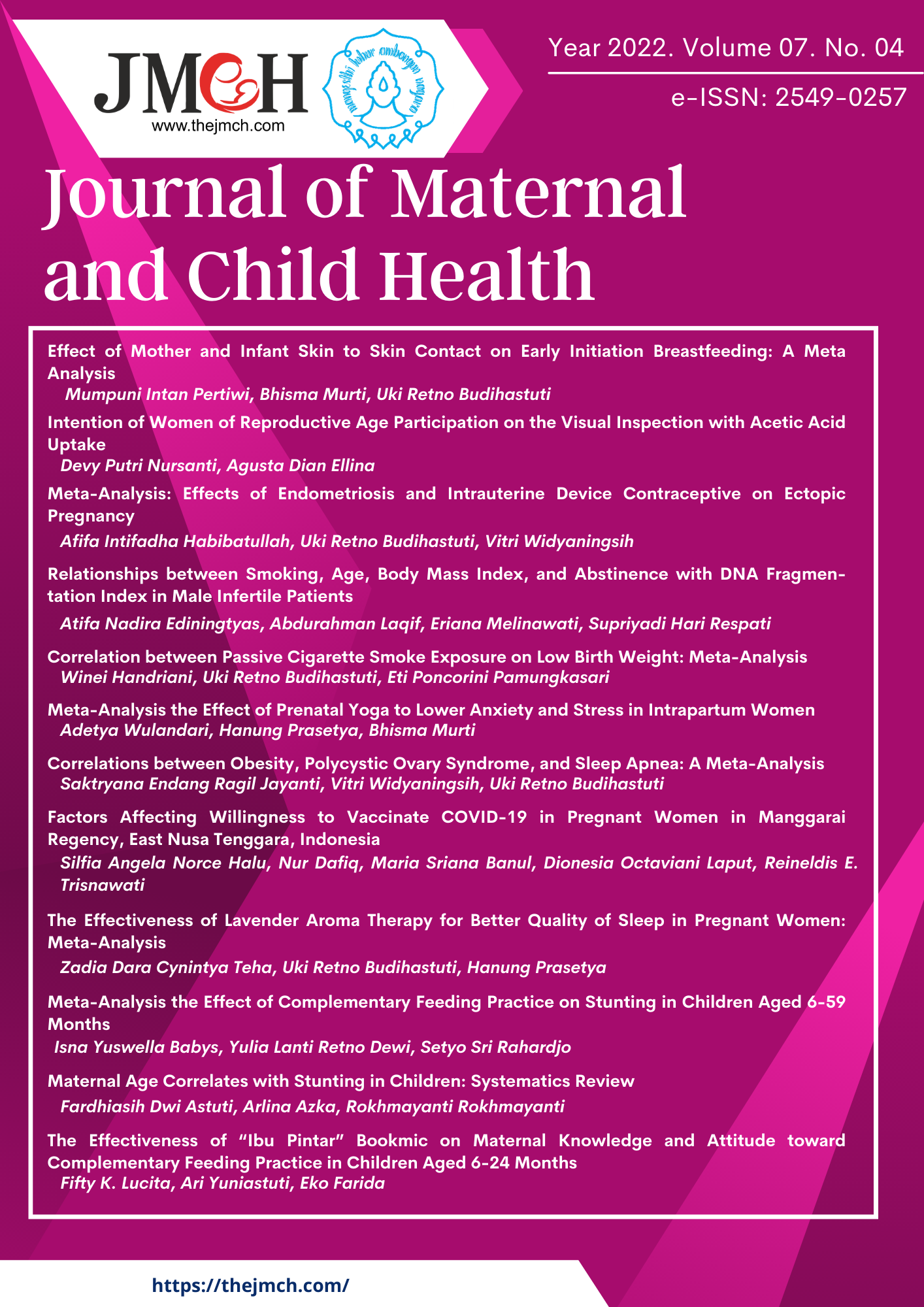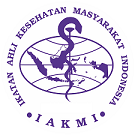Effect of Mother and Infant Skin to Skin Contact on Early Initiation Breastfeeding: A Meta Analysis
DOI:
https://doi.org/10.26911/thejmch.2022.07.04.01Abstract
Background: Skin to Skin Contact (SSC) of mothers and babies immediately after giving birth provides many benefits at the beginning of breastfeeding, an effective intervention can increase the competence of breastfeeding babies compared to just getting routine care. This study aims to analyze the primary study of the effect of mother-infant skin to skin contact on the success of the first breastfeeding with a meta-analysis.
Subjects and Method: This study is a systematic review and meta-analysis with the following PICO, population: mothers and newborns. Intervention: skin to skin contact. Comparison: Routine care. Outcome: Successful first breastfeeding. The articles used in this study were obtained from three databases, namely Google Scholar, Pubmed, Science Direct and Springerlink. Keywords to search for articles (“skin to skin contact” OR “early initiation breastfeeding” OR “kangaroo mother care” AND “first breastfeeding” OR “duration breastfeeding” AND “Randomized Control Trials” OR “RCT”). The articles included are full text in English and Indonesian with a Randomized Controlled Trial study design from 2011 to 2021 and reports on the Mean and SD in a multivariate analysis. Article selection is done by using PRISMA flow diagram. Articles were analyzed using the Review Manager 5.3 aplikasi application.
Results: A total of 10 randomized controlled trials from Iran, India, Pakistan, Egypt, and Thailand were selected for a systematic review and meta-analysis. The data collected showed that skin to skin contact increased the success of the first breastfeeding by 1.05 times compared to conventional method care (SMD= 1.10; 95% CI= 0.63 to 1.58; p<0.001).
Conclusion: Skin to skin contact can increase the success of the first breastfeeding.
Keywords: skin to skin contact, breastfeeding success, meta-analysis.
Correspondence: Alfi Makrifatul Azizah. Master’s Program in Public Health, Universitas Sebelas Maret. Jl. Ir. Sutami 36A, Surakarta 57126, Central Java, Indonesia. Email: alfimakrifatulazizahh@gmail.com. Mobile: +6285375335480.
How to Cite
References
Abdulghani N, Edvardsson K, Amir LH (2018). Worldwide prevalence of mother-infant skinto-skin contact after vaginal birth. PLoS One. 13(10):1–19. DOI: 10.1371/j ournal.po ne.0205696.
Agudelo SI, Molina CF, Gamboa OA, Acuna E (2021). Comparison of the effects of different skin-to-skin contact onset times on breastfeeding behavior. Breastfeed. Med. 16(12): 971–977. DOI: 10.1089/bfm .2021.0134.
Ali NB, Sabrina SP, Bal RB, Samantha H, Rashidul MA, Afsana K, Zubair S (2021). Prevalence and factors associated wi th skin-to-skin contact (SSC) practice: fndings from a population-based cross-sectional survey in 10 selected districts of Bangladesh. BMC Pregnancy Childbirth. 21(1):709. DOI: 10.1186/ s12 884021041893.
Almutairi WM, Ludington SM, Quinn GMT, Burant CJ, Al-Zahrani AE, Alshareef FH, Badr HA (2020). The Role of Skin-to-Skin Contact and Breastfeeding on Atonic Postpartum Hemorrhage. Nurs. Rep. 11(1): 1–11. DOI: 10 .3390/nursrep1 1010001.
Araújo KE, Dos CC, Caminha MF, Silva SL, Pereira, JD, Filho MB (2021). Skin to skin contact and the early initiation of breastfeeding: a cross-sectional study. Texto e Contexto Enferm. 13(5):1–14. DOI: 10.1590/1980265XTCE2020062.
Brimdyr K, Karin C, Jeni S,Yuki T (2018). An implementation algorithm to improve skin-to-skin practice in the first hour after birth. Matern. Child Nutr. 14(2): 1–15. DOI: 10.1111/mcn.12571.
Cadwell K, Kajsa B, Raylene P (2018). Mapping, measuring, and analyzing the process of skin-to-skin contact and early breastfeeding in the first hour after birth. Breastfeed. Med. 13(7): 485-492. DOI: 10.1089/bfm.2018.0048.
Chi Luong K, Long Nguyen T, Huynh Thi DH, Carrara HP, Bergman NJ (2016). Newly born low birthweight infants stabilise better in skin-to-skin contact than when separated from their mothers: a randomised controlled trial. Acta Paediatrica. Int. J. Pediatr. 105 (4): 381–390. DOI: 10.1111/apa.13164.
Cochrane (2014). RevMan 5.3 User Guide. Cochrane Library.
Cuijpers P, Weitz E, Cristea, IA, Twisk J (2016). Pre-post effect sizes should be avoided in meta-analyses. Epidemiol Psychiatr Sci. 26(4):364–368.DOI: 10.1017/S2045796 016000809.
Dayanand K, Widomska J (2018). Outcome measures in interventions that enhance breastfeeding initiation, duration, and exclusivity. Physiol. Behav. 176 (5): 139–148. DOI: 10.1097/ NMC.00000000000 00472.
Deys L, Wilson PV, Meedya DS (2021). What are women’s experiences of immediate skin to skin contact at caesarean section birth an integrative literature review. Midwifery. 101(6): 103. DOI: 10.1016/j. midw.2021.103063.
Diaz D, Sergio A, Maria JM, Eduardo A. Daniel M (2020). Effect of skin-to-skin contact at birth on early neonatal hospitalization. Early Hum.144. DOI: 10.1016/j.earlhum dev.2020.105020.
Essa RM, Abdel AI (2015). Effect of early maternal/ newborn skin-to-skin contact after birth on the duration of third stage of labor and initiation of breastfeeding. J Nurs Educ Pract.5(4). DOI: 10.5430/jn ep.v5n4p98.
Genna CW (2017). Sucking Skills in Breastfeeding Infants.eBook. Burlington, MA : Jones & Bartlett Learning. Burlington. https:// www.worldcat.org/title/supporting-sucking-skills-in-breastfeeding-infants/oclc/9534-93845.
Guala A, Boscardini L, Visentin R, Angellotti P, Grugni L, Barbaglia M, Chapin E, Castelli E, Finale E (2017). Skin-to-skin contact in cesarean birth and duration of breastfeeding: a cohort study. Sci. World J. 17(7): 1-5. DOI: 0.1155/2017/1940756
Ionio C, Ciuffo G, Landoni M (2021). Parent–infant skin-to-skin contact and stress regulation. Int. J. Environ. Res. Public Health. 8(9): 4695. DOI: 10.3390/ijerph 18094695
Li G, Zeng J, Tian J, Levine MAH, Thabane L (2020). Multiple uses of forest plots in presenting analysis results in heal-th research: A Tutorial. J. Clin. Epidemiol 117, 89–98.DOI: 10.1016 /J.JCLINEPI.2 019.09.021
Moore ER, Bergman N, Medley N (2016). Early skin-to-skin contact formothers and their healthy newborn infants. Cochrane, (11). DOI: 1 0.1002/14651858.CD003519.
Mukherjee D, Subhash CS, Venkatnarayan, Puja D (2020). Skin-to-skin contact at birth for vaginally delivered neonates in a tertiary care hospital: A cross-sectional study. Med J. Armed Forces India. 76(2): 180-184. DOI: 10.1016/j.m jafi.2018.11.0 08.
Murti B (2018). Prinsip dan Metode Riset Epidemiologi (5th ed.) (Principles and Methods of Epidemiological Research (5th ed.) Program Studi Ilmu Kesehatan Masyarakat, Program Pascasarjana, Universitas Sebelas Maret.
Nasrullah MJ (2021). Pentingnya inisiasi menyusu dini dan faktor yang mempengaruhinya (The importance of early initiation of breastfeeding and the factors that affect it). J. Medik. n.a. ilm. Kesehat. 02(02): 439–447.
Oksuz S, Korkut, Sevil I (2021). The effect of kangaroo mother care applied to the healthy newborns in the early postpartum period on breastfeeding: A randomized controlled trial. J Pak Med Assoc. 9(13): 2124-2129. DOI: 10.47391/J PMA.376.
Parela NM, Soesetijo FA, Rokhmah D (2021). Pengaruh usia dan pendidikan terhadap implementasi inisiasi menyusui dini (IMD) pada pasien post sectio caesarea (The effect of age and education on the implementation of early breastfeeding initiation (IMD) in post sectio caesarea patients). J. Multidiscip. Res. 4(1): 7. ISSN: 2716-2419.
Pratiwi K, Wulandari REP, Andriyani M (2021). Bounding attachment pada ibu yang dilakukan inisiasi menyusu dini (Bounding attachment in mothers who had early initiation of breastfeeding). J. Ners Kebidanan Indones. 17(1): 97-103. DOI: 10.31101/jkk.2071.
Prepelita T, Ricchi A, Patrizia M, Maria TM, Rosaria C, Laura F, Antonella N (2020). Self-efficacy in breastfeeding support: a research on Italian midwifery students. Acta Biomed; 91(2): 27-34. DOI: 10.23750/abmv91i1S.9149.
Purwaningsih H, Widuri W (2019). Pengaruh skin to skin contact (pmk) terhadap penurunan suhu tubuh pada bayi demam (The effect of skin to skin contact (PMK) on decreasing body temperature in feverish infants). IJP (Indones. J. Perawat). 3(1): 79. DOI: 10.3258 4/jpi.v3i1.268.
Reshma P, Sulochana, K, Jessy PS (2020). Effectiveness of skin-to-skin contact between mother and baby at birth on maternal and neonatal outcomes among parturients. Indian J Obstet Gynecol Res;7(2):196–200. DOI: 10.18231/j.ijogr .2020.041.
Şimşek S, Karahan N, Giko L (2017). Assessment of the impact of mother infant skin to skin contact at childbirth on breastfeeding. Konuralp tıp derg, 17 (9). DOI: doi.org/10.18521/ktd.2 96559.
Srivastava S, Gupta A, Bhatnagar A, Dutta S (2017). Effect of very early skin to skin contact on success at breastfeeding and preventing early hypothermia in neonates. Indian J. Public Health. 58(1). pp. 22–26. DOI: 10.4103/0019557X.1 28160.
Wada FH, Prabandari YS, dan Hapsari ED (2020). Bonding and attachment experience among postnatal mothers with spontaneous childbirth. Belitung Nurs. J. 6(1): 14–20. DOI: 10.33546/BNJ.779.











